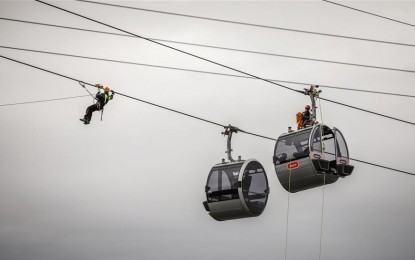Mass transit cable car plans draw potential private-sector partners

The country’s first cable car system to be proposed for public transportation has been drawing interest from private-sector players who want to team up with the government to realize the project, according to the Department of Transportation (DOTr).
Transportation Secretary Jaime Bautista, in an interview on state broadcaster PTV4, said that several groups have reached out to the government for a potential public-private partnership.
Bautista, however, did not provide details on the interested parties. For now, he said the project must undergo a feasibility study first to determine the project cost and passenger capacity.
The planned cable car system, which was broached as early as last year, will link the proposed Taytay station of Metro Rail Transit Line 4 (MRT 4) to Antipolo City.
MRT 4 is a 13.4-kilometer elevated railway mass-transit system. It is designed to have 10 stations that link Taytay to Ortigas central business district.
Timothy John Batan, transport undersecretary for planning and project development, earlier said they planned to kick-start the bidding process for the project in 2026.
Construction activities, meanwhile, are targeted to be completed by 2028.
Last month, the Bases Conversion and Development Authority signed a memorandum of understanding with Japanese firm Zip Infrastructure Co. Ltd. to conduct a feasibility study on cable cars at Camp John Hay, Baguio City.
Traffic congestion
The DOTr said this would provide an alternative transport system that could ease traffic congestion.
The government has been pushing for mass transport projects across the country to decongest the roads and improve inter-regional linkages.
Among the big-ticket projects in the pipeline is the Metro Manila Subway, which is designed to have 17 stations connecting Valenzuela City to Pasay City. It is expected to serve over 519,000 passengers daily, once operational.
The government is also working on the North-South Commuter Railway, which will have 35 stations linking Pampanga to Laguna. Once operational, it can accommodate 800,000 passengers daily.
Along with this, the DOTr and Japan International Cooperation Agency are creating a 30-year rail master plan covering the National Capital Region, Central Luzon and Calabarzon. INQ

















